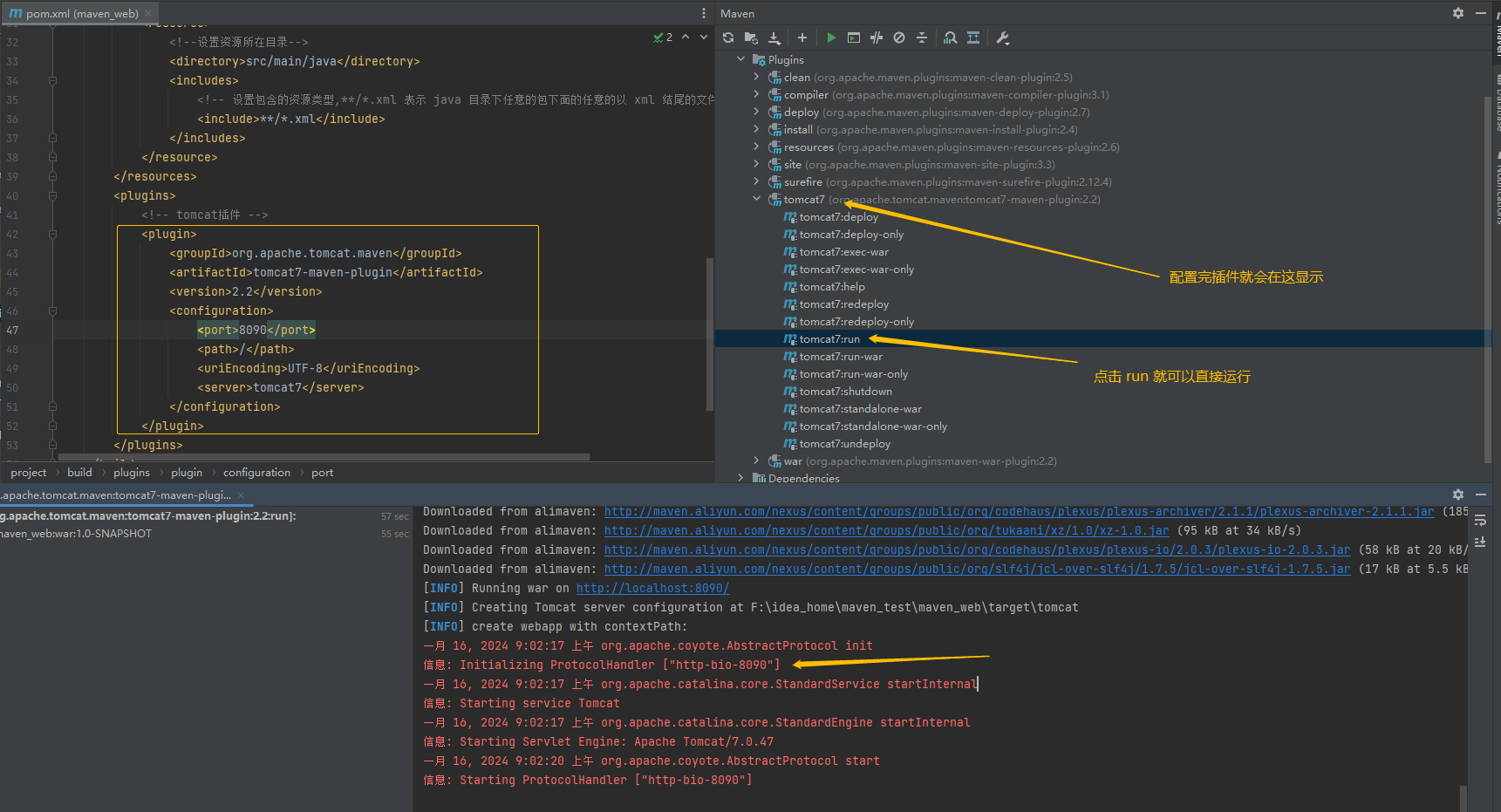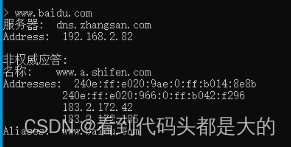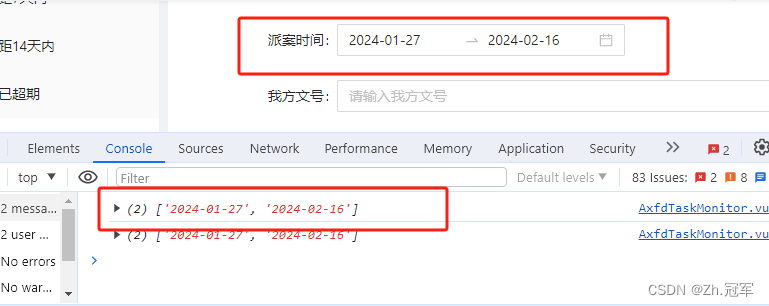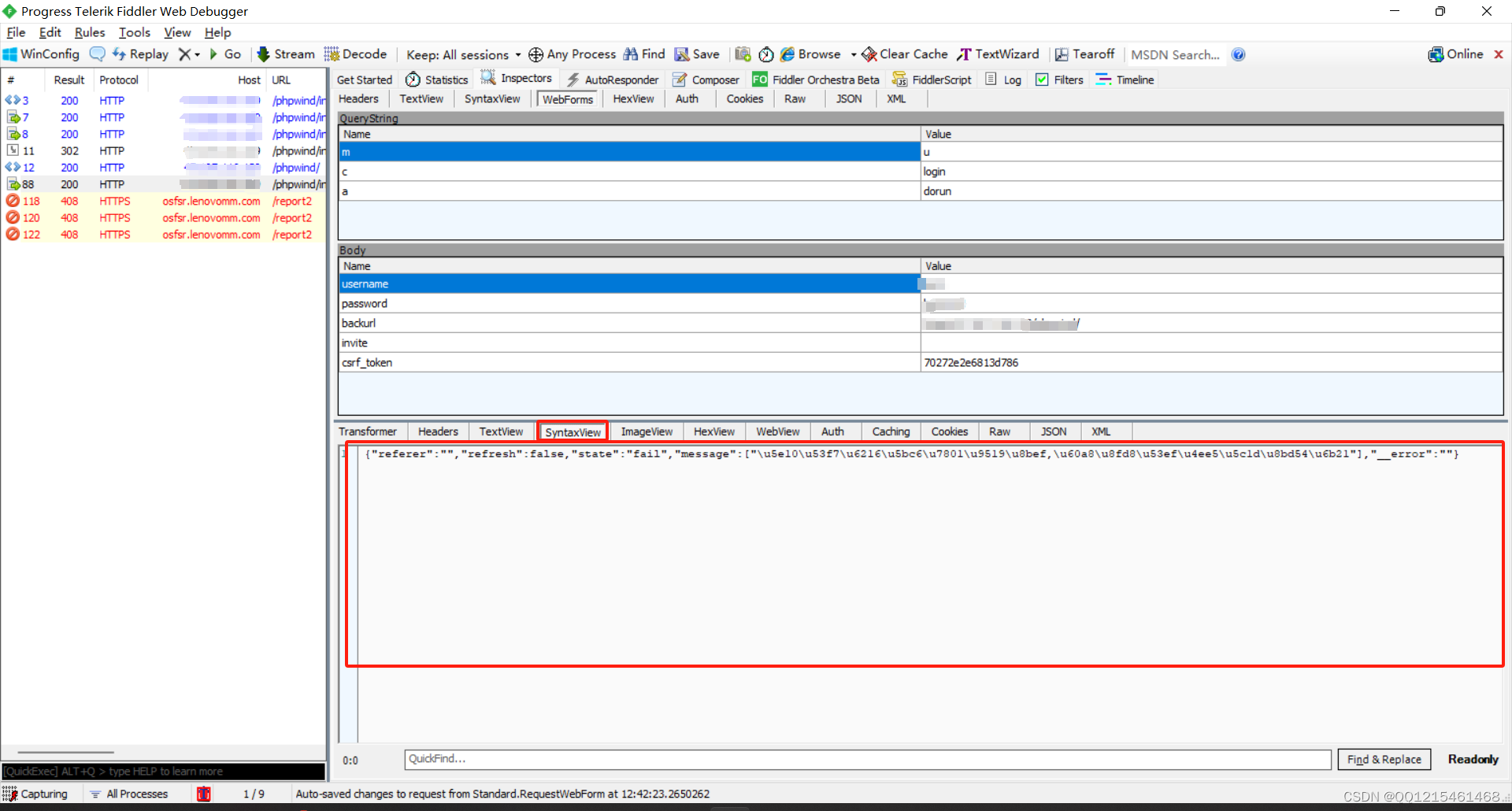目录
一、实验目的
1. 邻接矩阵
2. 邻接矩阵表示图的结构定义
3. 图的初始化
4. 边的添加
5. 边的删除
6. Dijkstra算法
三、实验内容
实验内容
代码
截图
分析
一、实验目的
1.掌握图的邻接矩阵的存储定义;
2.掌握图的最短路径(Dijsktra)算法的实现。
二、实验原理
1. 邻接矩阵
邻接矩阵是一种表示图的方法。它是一个二维数组,用于表示图中各个顶点之间的连接关系。如果图是有向图,那么邻接矩阵是对称的;如果是无向图,邻接矩阵可能不是对称的。
顶点的编号: 假设图有n个顶点,通常是从1到n。
构建矩阵: 创建一个n x n的矩阵,其中元素a[i][j]表示顶点i到顶点j是否有边。如果存在边,通常用1表示;如果不存在边,通常用0表示。
例如,对于无向图,如果顶点i和顶点j之间有边,则a[i][j]和a[j][i]都设置为1。对于有向图,只需设置a[i][j]为1表示从顶点i到顶点j有一条有向边。
权重: 如果图中的边有权重,可以在矩阵中存储这些权重。矩阵的元素a[i][j]可以表示从顶点i到顶点j的权重值。
2. 邻接矩阵表示图的结构定义
#define MAX_SIZE 100
struct Graph {
int numVertices;//节点数
int adjMatrix[MAX_SIZE][MAX_SIZE];//邻接矩阵
};3. 图的初始化
创建一个空的图数据结构并为其设置初始状态。
void InitializeGraph(struct Graph* graph,int num) {
int i, j;
graph->numVertices = num;
for (i = 0; i < num; i++) {
for (j = 0; j < num; j++) {
graph->adjMatrix[i][j] = 0;
}
}
}4. 边的添加
在图中增加边,将该边置为1,表示存在,或者权值
若是无向图,由于对称性,则需要改变两条边
//添加边
void addEdge(struct Graph* graph, int startVertex, int endVertex) {
graph->adjMatrix[startVertex][endVertex] = 1;
//若是无向图
graph->adjMatrix[endVertex][startVertex] = 1;
}5. 边的删除
置为0(不存在)或者无限大的权值
void deleteEdge(struct Graph* graph, int startVertex, int endVertex) {
graph->adjMatrix[startVertex][endVertex] = 0;
//若是无向图
graph->adjMatrix[endVertex][startVertex] = 0;
}6. Dijkstra算法
Dijkstra算法是一种用于在带有非负权重的图中找到单源最短路径的算法。该算法的基本思想是从起始顶点开始,逐步扩展到离起始顶点的距离最短的顶点,直到到达目标顶点为止。
初始化: 对于每个顶点v,初始化距离值dist[v]为无穷大(表示尚未到达该顶点),并将起始顶点的距离值dist[start]设置为0。创建一个优先队列(最小堆),将起始顶点加入队列。
更新距离值: 从优先队列中取出距离值最小的顶点u。对于u的每个邻接顶点v,如果通过u可以缩短到达v的距离(dist[start] + weight(u, v) < dist[v]),则更新dist[v]的值。更新后,将v加入优先队列。
重复步骤2: 重复上述步骤,直到优先队列为空。这样,对于每个顶点,dist数组中存储的值就是从起始顶点到达该顶点的最短路径距离。
Dijkstra算法的关键在于通过贪心策略,每次选择距离起始顶点最近的顶点进行扩展。这确保了每个顶点的最短路径被逐步确定,直到到达目标顶点
//Dijkstra算法
void dijkstra(struct Graph* graph, int startVertex) {
int dist[MAX_SIZE]; // 存储从起始节点到各节点的最短距离
int visited[MAX_SIZE] = { 0 }; // 标记节点是否被访问过
// 初始化距离数组
for (int i = 0; i < graph->numVertices; i++) {
dist[i] = INT_MAX;
}
// 起始节点到自身的距离为0
dist[startVertex] = 0;
for (int count = 0; count < graph->numVertices - 1; count++) {
int minDist = 9999;
int minIndex;
// 选择距离最小的未访问节点
for (int v = 0; v < graph->numVertices; v++) {
if (!visited[v] && dist[v] < minDist) {
minDist = dist[v];//当前最短距离
minIndex = v;//当前最短的点
}
}
// 标记节点为已访问
visited[minIndex] = 1;
// 更新最短距离数组
//!visited[v]:检查节点 v 是否已经被访问过,如果节点已经被访问过,则不需要更新最短距离。
//graph->adjacencyMatrix[minIndex][v] != 9999:检查从当前节点 minIndex 到节点 v 是否存在边。9999 表示两个节点之间没有直接的连接,因此如果这个条件为真,说明节点 minIndex 和节点 v 之间存在边。
// dist[minIndex] != 9999:检查起始节点到节点 minIndex 的最短距离是否已经被初始化,如果没有被初始化,说明当前节点 minIndex 不可达,无法通过它来更新其他节点的距离。
//(dist[minIndex] + graph->adjMatrix[minIndex][v] < dist[v]):检查通过当前节点 minIndex 更新节点 v 的距离是否比已知的最短距离 dist[v] 更短。如果是,就更新 dist[v] 为更短的距离。
for (int v = 0; v < graph->numVertices; v++) {
if (!visited[v] && graph->adjMatrix[minIndex][v] != 9999 && dist[minIndex] != 9999 && (dist[minIndex] + graph->adjMatrix[minIndex][v] < dist[v])) {
dist[v] = dist[minIndex] + graph->adjMatrix[minIndex][v];
}
}
}
// 打印最短距离
cout<<"从"<< startVertex<<"节点为起点"<<endl;
for (int i = 0; i < graph->numVertices; i++) {
cout<<"到"<<i<<"节点的最短距离为:" << dist[i]<<endl;
}
}三、实验内容
实验内容
必做内容:
设计安徽大学的校园平面图,所含景点不少于 8 个。以图中顶点表示学校内各景点,存放景点的名称、景点介绍信息等;以边表示路径,存放路径长度信息。要求将这些信息保存在文件 graph.txt 中,系统执行时所处理的数据要对此文件分别进行读写操作。
1.从文件 graph.txt 中读取相应数据, 创建一个图,使用邻接矩阵表示图;
2.景点信息查询:为来访客人提供校园任意景点相关信息的介绍;
3.问路查询:为来访客人提供校园任意两个景点之间的一条最短路径;
选做内容(对文件进行操作,相应信息变化后,再次进行景点信息查询和
问路查询时应该有所体现):
1. 修改一个已有景点的相关信息;
2. 增加一个新景点及其相关信息;
3. 增加一条新的路径;
4. 删除一个景点及其相关信息;
5. 删除一条路径。
代码
#define _CRT_SECURE_NO_WARNINGS
#include<fstream>
#include<iostream>
using namespace std;
#define MAX_SIZE 100
struct Graph {
int numVertices;//节点数
int adjMatrix[MAX_SIZE][MAX_SIZE];//邻接矩阵,用来储存距离
char address[MAX_SIZE][MAX_SIZE];//景点名称
char intro[MAX_SIZE][MAX_SIZE];//景点介绍
};
//图的初始化
void InitializeGraph(struct Graph* graph,int num) {
int i, j;
graph->numVertices = num;
for (i = 0; i < num; i++) {
for (j = 0; j < num; j++) {
graph->adjMatrix[i][j] = 9999;
}
}
}
//添加边
void addEdge(struct Graph* graph, int startVertex, int endVertex,int length) {
graph->adjMatrix[startVertex][endVertex] = length;
//若是无向图
graph->adjMatrix[endVertex][startVertex] = length;
}
//删除边
void deleteEdge(struct Graph* graph, int startVertex, int endVertex) {
graph->adjMatrix[startVertex][endVertex] = 0;
//若是无向图
graph->adjMatrix[endVertex][startVertex] = 0;
}
//找到编号对应的景点名称
void find_address(struct Graph* graph, int index) {
cout << graph->address[index];
}
//Dijkstra算法
void dijkstra(struct Graph* graph, int startVertex, int endVertex) {
int visited[MAX_SIZE] = { 0 };//记录是否被访问过
int pre[MAX_SIZE] = { startVertex };//记录前驱点编号
int min_leng[MAX_SIZE];
for (int i = 0; i < MAX_SIZE; i++) {
min_leng[i] = 9999;
}
visited[startVertex] = 1;
int min_length = 9999;
int min_index = startVertex;
//第一轮
for (int j = 0; j < graph->numVertices; j++) {
if (visited[j] == 0) {//如果未被访问过
//cout << graph->adjMatrix[startVertex][j] << " " << min_leng[j] << endl;
if (graph->adjMatrix[startVertex][j] < min_leng[j]) {//如果新的起始点到达终点的距离更短,则前驱节点为新的起始点
//find_address(graph, j);
pre[j] = startVertex;
min_leng[j] = graph->adjMatrix[startVertex][j] ;
}
}
//cout << endl;
for (int j = 0; j < graph->numVertices; j++) {//找最短路径作为新一轮的起始点
if (visited[j] == 0) {//如果未被访问过
if (min_leng[j] < min_length) {
min_length = min_leng[j];
min_index = j;
}
}
}
visited[min_index] = 1;
}
for (int i = 0; i < graph->numVertices - 2; i++) {//共顶点数-2轮
for (int j = 0; j < graph->numVertices; j++) {
if (visited[j] == 0) {//如果未被访问过
//cout <<graph-> adjMatrix[min_index][j]<<" " << min_leng[j] << endl;
if ((graph->adjMatrix[min_index][j] + min_length) < min_leng[j]) {//如果新的起始点到达终点的距离更短,则前驱节点为新的起始点
//find_address(graph, j);
pre[j] = min_index;
min_leng[j] = graph->adjMatrix[min_index][j] + min_length;
}
}
//cout << endl;
}
//cout << "更新一轮"<<endl;
for (int j = 0; j < graph->numVertices; j++) {
//cout << min_leng[j] << " ";
}
min_length = 9999;
min_index = startVertex;
for (int j = 0; j < graph->numVertices; j++) {//找最短路径作为新一轮的起始点
if (visited[j] == 0) {//如果未被访问过
if (min_leng[j] < min_length) {
min_length = min_leng[j];
min_index = j;
}
}
}
visited[min_index] = 1;
//cout << "这一轮起始点为";
//find_address(graph, min_index);
// cout << endl << "到达起始点距离为" << min_length << endl;
}
cout <<"最短距离为:"<< min_leng[endVertex]<<endl;
//输出最短路径,从后往前找前驱
cout << "最短路径为:";
int count = 2;
int road[MAX_SIZE] ;
for (int i = 0; i < MAX_SIZE; i++) {
road[i] = endVertex;
}
road[0] = startVertex;
int end = endVertex;//尾
while (pre[end] != startVertex) {//计算路径中的景点数
count++;
end = pre[end];
}
end = endVertex;
for (int i = count - 2; i >= 0; i--) {
road[i] = pre[end];
end = pre[end];
}
int flag = 1;
for (int i = 0; i < count; i++) {
if (flag == 0) {
cout << "->";
}
find_address(graph, road[i]);
flag = 0;
}
return;
}
//找到该景点对应的编号
int find_index(struct Graph* graph, char string[]) {
for (int i = 0; i < graph->numVertices; i++) {
if (strcmp(string, graph->address[i]) == 0) {
return i;
}
}
cout << "不存在该景点" << endl;
return -1;
}
//景点信息查询
void volun1(struct Graph* graph) {
cout << "本校景点有:" << endl;
for (int i = 0; i < graph->numVertices; i++) {
cout <<i<<":"<< graph->address[i] << endl;
}
char string1[MAX_SIZE];
cout << "请输入你要查询的景点:";
cin >> string1;
int index = find_index(graph, string1);
cout << graph->intro[index] << endl;
}
//最短路径查询
void volun2(struct Graph* graph) {
char source[MAX_SIZE], destination[MAX_SIZE];
cout << "请输入起始景点和目的景点:";
cin >> source >> destination;
int start = 0, end = 0;
start = find_index(graph, source);
end = find_index(graph, destination);
dijkstra(graph, start, end);
cout << endl;
}
//增加景点相关信息
void volun3(struct Graph* graph) {
char address[MAX_SIZE], intro[MAX_SIZE];
cout << "请输入你要增加的景点名称及其相关信息:"<<endl;
cin >> address >> intro;
//将信息复制进去
strcpy(graph->address[graph->numVertices], address);
strcpy(graph->intro[graph->numVertices], intro);
graph->numVertices++;//修改节点数
//相关路径全改为无穷大
for (int i = 0; i < graph->numVertices; i++) {
graph->adjMatrix[i][graph->numVertices - 1] = 9999;
}
for (int i = 0; i < graph->numVertices; i++) {
graph->adjMatrix[graph->numVertices - 1][i] = 9999;
}
}
//修改景点的相关信息
void volun4(struct Graph* graph) {
char address[MAX_SIZE], intro[MAX_SIZE];
cout << "请输入你要修改的景点名称及其相关信息:" << endl;
cin >> address >> intro;
//找到编号
int des_index = find_index(graph, address);
//修改
memset(graph->intro[des_index], MAX_SIZE, sizeof(char));//清空
strcpy(graph->intro[des_index], intro);
}
//增加路径
void volun5(struct Graph* graph) {
char source[MAX_SIZE], destination[MAX_SIZE];
int length;
cout << "请输入你要增加的路径:" << endl;
cin >> source >> destination >> length;
int start = find_index(graph, source);
int end = find_index(graph, destination);
addEdge(graph, start, end, length);
}
//删除一个景点及其相关信息
void volun6(struct Graph* graph) {
char address[MAX_SIZE];
cout << "请输入你要删除的景点:" << endl;
cin >> address;
int index = find_index(graph, address);
//清空
memset(graph->address[index], MAX_SIZE, sizeof(char));
memset(graph->intro[index], MAX_SIZE, sizeof(char));
}
//删除一条路径
void volun7(struct Graph* graph) {
char source[MAX_SIZE], destination[MAX_SIZE];
cout << "请输入你要删除的路径:" << endl;
cin >> source >> destination;
int start = find_index(graph, source);
int end = find_index(graph, destination);
deleteEdge(graph, start, end);
}
int main() {
struct Graph q;
int num_V, num_a;//顶点数目,边的个数
FILE* filePointer;
filePointer = fopen("C:\\Users\\Administrator\\Desktop\\graph.txt", "r");
// 检查文件是否成功打开
if (filePointer == NULL) {
cout << "无法打开文件";
return 1; // 退出程序
}
char buffer[1000];
char Address[MAX_SIZE], Intro[MAX_SIZE];
// 读取一行数据
if (fgets(buffer, sizeof(buffer), filePointer) != NULL) {
if (sscanf(buffer, "%d %d", &num_V, &num_a) == 2) {
q.numVertices = num_V;
//cout << num_V << " " << num_a<<endl;
}
else {
cout<<"错误:无法从字符串中提取两个数字。" << endl;
}
}
else {
cout<<"错误:文件为空或无法读取。" << endl;
}
InitializeGraph(&q, num_V);//初始化图
//读取景点名称及其介绍
for (int i = 0; i < num_V; i++) {
if (fgets(buffer, sizeof(buffer), filePointer) != NULL) {
if (sscanf(buffer, "%s %s", Address, Intro) == 2) {
strcpy(q.address[i], Address);
strcpy(q.intro[i], Intro);
//cout << q.address[i] << endl;
//cout << q.intro[i] << endl;
}
else {
printf("错误:无法从字符串中提取两个字符串。\n");
}
}
else {
cout << "错误:文件为空或无法读取。" << endl;
}
}
//读取景点之间距离
char source[MAX_SIZE], destination[MAX_SIZE];
int length=0;
for (int i = 0; i < num_a; i++) {
if (fgets(buffer, sizeof(buffer), filePointer) != NULL) {
if (sscanf(buffer, "%s %s %d", source, destination,&length) == 3) {
int index1 = find_index(&q, source);
int index2 = find_index(&q, destination);
q.adjMatrix[index1][index2] = length;
q.adjMatrix[index2][index1] = length;
//cout << index1 << " " << index2 << " " << length << endl;
}
else {
cout<<"错误:无法从字符串中提取两个字符串,一个数字。"<<endl;
}
}
else {
cout << "错误:文件为空或无法读取。" << endl;
}
}
// 关闭文件
fclose(filePointer);
//信息填充完毕,接下来是查阅环节
int code;
cout << "********************欢迎来到安徽大学!********************" << endl;
cout << " 1.查询景点信息" << endl;
cout << " 2.问路查询" << endl;
cout << " 3.增加一个景点及其相关信息" << endl;
cout << " 4.修改一个景点的相关信息" << endl;
cout << " 5.增加一个新的路径" << endl;
cout << " 6.删除一个景点及其相关信息" << endl;
cout << " 7.删除一条路径" << endl;
cout << " 8.退出" << endl;
cout << "********************安大校园导游系统*********************" << endl;
cout << "请选择需要的服务:(1-8)" << endl;
cin >> code;
while (code != 8) {
switch (code)
{
case 1: volun1(&q); break;
case 2: volun2(&q); break;
case 3: volun3(&q); break;
case 4: volun4(&q); break;
case 5: volun5(&q); break;
case 6: volun6(&q); break;
case 7: volun7(&q); break;
}
cin >> code;
}
cout << "退出" << endl;
return 0;
}截图
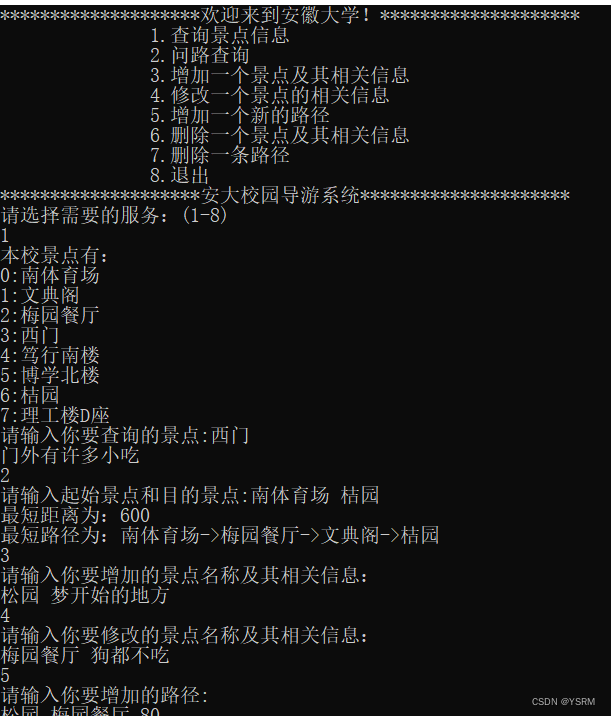
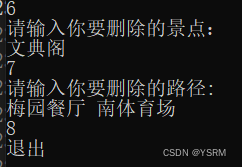
分析
对于上述代码,是存在一个问题的,比如增加一个节点,删除俩个节点,总数目减少,但是最大索引值是在增加的,所以再次实现其他功能的时候是不切实际的
way1:提供一个有效位数组,按最大索引值的范围查找
way2: 当删除时,后面的节点索引值应该加以改变,但是很麻烦
此外上述代码提到了sscanf函数
sscanf函数接受一个字符串作为输入,并根据指定的格式从该字符串中读取数据,然后将数据存储在相应的变量中。#include <stdio.h> int sscanf(const char *str, const char *format, ...);
str是包含格式化数据的输入字符串。format是描述输入字符串中数据格式的格式字符串。- 可变参数(
...)是用于存储从输入字符串中读取的数据的变量列表。

